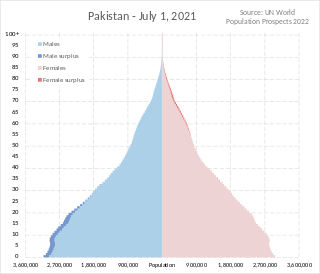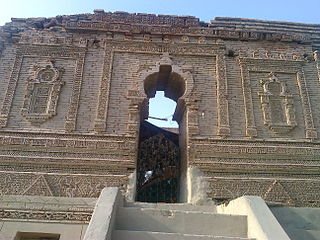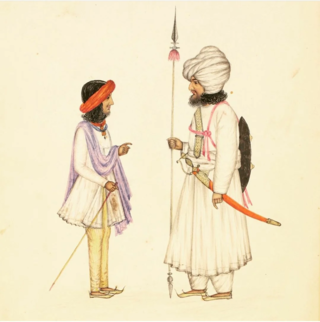
The history of Pakistan preceding the country's creation in 1947. Although, Pakistan was created in 1947 as a whole new country by the British through partition of India, but the history of the land extends much further back and is intertwined with that of Afghanistan, India, and Iran. Spanning the northwestern expanse of the Indian subcontinent and the eastern borderlands of the Iranian plateau, the region of present-day Pakistan served both as the fertile ground of a major civilization and as the gateway of South Asia to Central Asia and the Near East.

Pakistan had a population of 241,492,197 according to the final results of the 2023 Census. This figure includes Pakistan's four provinces e.g. Punjab, Sindh, KPK, Balochistan and Islamabad Capital Territory. AJK and Gilgit-Baltistan's census data is yet to be approved by CCI Council of Pakistan. Pakistan is the world's fifth most populous country.

Punjab, historically known as Pentapotamia or Panchanada, is a historical, geopolitical, ethnolinguistic and cultural region in the northwestern part of South Asia, along the five major eastern tributaries of the Indus River in the Indian Subcontinent. The region is divided between modern-day eastern-Pakistan and northwestern-India.

Punjab is a province of Pakistan. Located in central-eastern region of the country, Punjab is the second-largest province of Pakistan by land area and the largest by population. Lahore is the capital and the largest city of the province. Other major cities include Faisalabad, Rawalpindi, Gujranwala and Multan.

Bahawalpur was a princely state in subsidiary alliance with British Raj and later Dominion of Pakistan, that was a part of the Punjab States Agency. The state covered an area of 45,911 km2 (17,726 sq mi) and had a population of 1,341,209 in 1941. The capital of the state was the town of Bahawalpur.

The Punjabis are an Indo-Aryan ethnolinguistic group associated with the Punjab region of South Asia, comprising areas of present-day eastern Pakistan and northwestern India. They share a common history, culture and language, generally speaking Standard Punjabi or various Punjabi dialects on both sides.

Kasur is a city to the south of Lahore, in the Pakistani province of Punjab. The city serves as the headquarters of Kasur District. Kasur is the 16th largest city in Punjab and 24th largest in Pakistan, by population. It is also known for being the burial place of the 17th-century Sufi-poet Bulleh Shah. It is farther west of the border with neighboring India, and bordered to Lahore, Sheikhupura and Okara Districts of Punjab. The city is an aggregation of 26 fortified hamlets overlooking the alluvial valleys of the Beas and Sutlej rivers.

Muzaffargarh District is a district of the Punjab province of Pakistan. Its capital is Muzaffargarh city. It lies on the bank of the Chenab River.

Hinduism in Afghanistan is practiced by a tiny minority of Afghans, about 30-40 individuals as of 2021, who live mostly in the cities of Kabul and Jalalabad. Afghan Hindus are ethnically Pashtun, Hindkowan (Hindki), Punjabi, or Sindhi and primarily speak Dari, Pashto, Hindko, Punjabi, Sindhi, and Hindustani (Hindi-Urdu).

Hanumangarh district is a district in the state of Rajasthan in India. The city of Hanumangarh is the district headquarters and its largest city.
The history of Peshawar is intertwined with the history of the broader Indian subcontinent. The region was known as Puruṣapura in Sanskrit, literally meaning "city of men". Being among the most ancient cities of the Indian subcontinent, Peshawar has for centuries been a center of trade between West Asia, Central Asia, and the Indian subcontinent.

Punjabi Hindus are adherents of Hinduism who identify ethnically, linguistically, culturally, and genealogically as Punjabis and are natives of the Punjab region of the Indian subcontinent. Punjabi Hindus are the second-largest religious group of the Punjabi community, after the Punjabi Muslims. While Punjabi Hindus mostly inhabit the Indian state of Punjab, as well as Haryana, Himachal Pradesh, Delhi, and Chandigarh today, many have ancestry across the greater Punjab region, which was partitioned between India and Pakistan in 1947.

Indian Sikhs number approximately 21 million people and account for 1.7% of India's population as of 2011, forming the country's fourth-largest religious group. The majority of the nation's Sikhs live in the northern state of Punjab, which is the only Sikh-majority administrative division in the world.
Awtar Singh or Awtar Singh Khalsa was an Afghan politician. He was the Sikh representative to the Loya Jirga from Paktia Province. He was the only non-Muslim representative there. His native tongue was Punjabi. He was in charge of the main Sikh temple (Gurdwara) in Kabul.

Hindkowans, also known as the Hindki, is a contemporary designation for speakers of Indo-Aryan languages who live among the neighbouring Pashtuns, particularly the speakers of various Hindko dialects of Western Punjabi (Lahnda). The origins of the term refer merely to the speakers of Indo-Aryan languages rather than to any particular ethnic group. The term is not only applied to several forms of "Northern Lahnda" but also to the Saraiki dialects of the districts of Dera Ghazi Khan, Mianwali, and Dera Ismail Khan, which border the southern Pashto-speaking areas.
Khushab Tehsil, is an administrative subdivision (tehsil), Khushab District in the Punjab province of Pakistan.

Sikhism inAfghanistan in the contemporary era is limited to small populations, primarily in major cities, with the largest numbers of Afghan Sikhs living in Jalalabad, Ghazni, Kabul, and to a lesser extent in Kandahar and Khost. Sikhs have been the most prevalent non-Muslim minority in Afghanistan, and despite the many political changes in recent Afghan history, governments and political groups have generally not indulged in openly discriminating against the Sikh minority; however, their status have been severely impacted amid the country's conflict since 1978.

Pakistan is an ethnically and linguistically diverse country. The major Pakistani ethnolinguistic groups include Punjabis, Pashtuns, Sindhis, Gujjar, Saraikis, Muhajirs, Balochs, Paharis and Brahuis, with significant numbers of Baltis, Kashmiris, Chitralis, Shina, Kohistanis, Torwalis, Hazaras, Burusho, Wakhis, Kalash, Siddis, Uzbeks, Nuristanis, Pamiris, Hindkowans, Kyrgyz, Turkmen, Uyghurs and other various minorities.

Punjabi Muslims are ethnic Punjabis who are adherents of Islam; they constitute the largest religious subdivision within the Punjabi people with a population of more than 112 million. They are the third-largest ethnic group among Muslims, globally, after Arabs and Bengalis.
Pathans in India or simply known as Pathans are citizens or residents of India who are of ethnic Pashtun ancestry. "Pathan" is the local Hindavi term for an individual who belongs to the Pashtun ethnic group, or descends from it. The term additionally finds mention among Western sources, mainly in the colonial-era literature of British India. Historically, the term "Afghan" was also synonymous with the Pathans. The Pathans originate from the Eastern Afghanistan and Northwestern Pakistan regions, ethnolinguistically known as Pashtunistan.


















